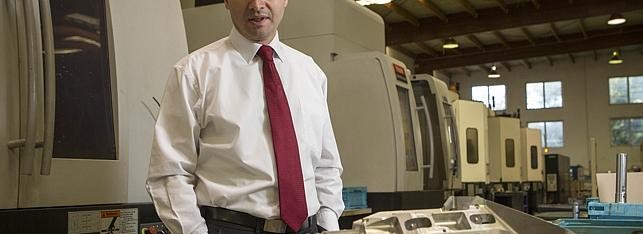A Brisbane aerospace contractor, Ferra Engineering, plans to be the first in the world to use a revolutionary technique known as additive or 3D manufacturing in commercial mass production.
The company, which supplies Boeing and Airbus, has a $200 million agreement with Lockheed Martin to make two-metre-long titanium parts for the F-35 joint strike fighter (JSF).
Prototype tailfin parts have already been manufactured in the United States, with up to $10 million earmarked for production equipment to be ordered from US-supplier Sciaky at the end of 2012 or early 2013, according to Ferra’s owner and chief executive, Mark Scherrer.
“The direct manufacturing method we will use will allow us to make parts more efficiently,” Mr Scherrer said yesterday. “I think we will be the first in the world and not just Australia to apply this technology in aerospace.”
Additive manufacturing is being hailed as a third industrial revolution as it turns mass production on its head by allowing computer designed parts to be made in batches of one.
The technique, which uses lasers or ion beams to deposit plastic or metal in layers that gradually build up a complete part, has so far been confined to rapid prototyping because of its high cost. However, the extraordinary complexity of the JSF, the various machining operations needed to make its titanium parts and the large amount of metal waste created, are turning the prototyping method into an everyday manufacturing tool.
The chairman of the Automotive Industry Innovation Authority, David Charles, said a handful of companies in Germany and the UK were using additive manufacturing techniques in small-scale production.
He said Australia’s small and medium-size enterprises (SMEs) in the aerospace, automotive and medical instrument sectors were likely to be the first to move to the latest production technique.
“For Ferra to use this in production would be a first in Australia,” said Dr Charles, who is a former head of the federal Industry Department. “This technique allows the possibility for Australia to get back into some parts of high-value manufacturing.”
The arrival of additive manufacturing would be a fillip for the local manufacturing sector, which is suffering from the high dollar. It would also be a vindication of the government’s $200 million investment as a partner in developing the JSF.
Ferra and Lockheed Martin have been working for seven years developing a system using an ion beam mounted in a vacuum chamber that gradually builds up the JSF’s complex titanium parts. “The JSF will be one of the highest-volume aircraft ever built and literally thousands of parts are needed,” Mr Scherrer said.
“Using additive manufacturing, we aim to use less metal and less machining time to cut the cost of the components in half.”
Ferra may seem an unlikely pioneer, turning over only $15 million and employing 70 people in manufacturing. It also operates two logistics centres in the US.
However, its components include weapons release systems for the JSF and top secret parts protected by US-Australia agreements that are at the cutting edge of technology. In 2011, Ferra was named Boeing’s global “supplier of the year” for its work on the 737, 747, 777 and 787 aircraft.
Mr Scherrer admits that as the owner of an SME, he is taking a calculated business risk. “However, if you have a couple of hundred million dollars worth of long-term business behind you, then obviously it is a great opportunity,” he said.
Australian Financial Review
http://afr.com/p/national/local_firm_leads_with_manufacturing_cdMd7rMhCh9CalDDxrRorI
PETER ROBERTS













